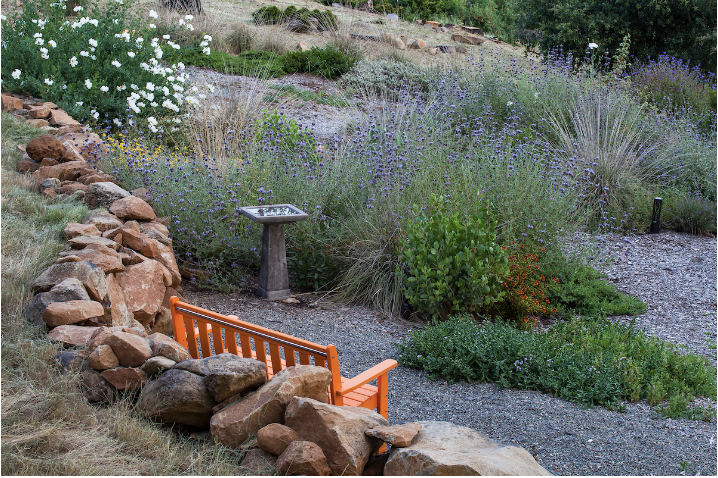
LANDSCAPE (START HERE!)

Defensible space is an area around a home or other structure that is designed, modified, and/or maintained in a way that increases the probability of the home surviving a wildfire event. Creating a sustainable, fire-wise garden takes careful planning, and it may be helpful to consult with a local landscape professional knowledgeable about the techniques described here.
Within the 100’ defensible space, “fuel breaks” are a vital component in fire-wise design. Create fuel breaks with driveways, low-water use lawns, walkways, patios, parking areas, areas with inorganic mulches such as decorative rock, and with fences or walls of nonflammable materials such as rock, brick, metal or concrete to slow the spread of fire and separate your home from ignition sources. Leaving open space around the home and within the landscape also allows firefighters leeway to fight a fire safely and effectively. While bare soil can’t burn, it is not promoted as a firewise element due to aesthetic and soil erosion concerns, although some small patches of bare earth can provide habitat for native bees.

Defensible space is typically considered to encompass a distance of 100’ from structures, and is divided into zones based on their distance from those structures. In the Design tab, chose a zone to learn about the defensible space recommendations for:
- Zone 0, The Ember-Resistant Zone, 0-5’ from structures
- Zone 1, The Home Protection Zone, 5-30’ from structures
- Zone 2, The Reduced Fuel/Thinning Zone, 30-100’ from structures
Home landscapes provide many ecological services, and sustainable landscape practices will help keep plants healthy and less prone to ignition. At the same time, sustainable practices can lower maintenance needs, and encourage native wildlife to utilize the garden for important habitat.
Sustainable landscape practices:
- Keep plants well pruned and hydrated to reduce risk of combustibility.
- Keep soil in place, and promote and support soil microorganisms, using compost and mulch.
- Conserve water: Use drought tolerant (where possible, native) plants; where irrigation is needed, adjust seasonally; slow, spread, and sink water into the soil; mulch.
- Minimize pesticides: use non-toxic pest control methods, using chemical pesticides only as a last resort
- Support biodiversity: a more biodiverse landscape is more resilient, as bird species such as hummingbirds, swallows or bluebirds, for instance, provide services like pollination, and pest control.
- Sequester carbon: Plants and soil absorb and store vast quantities of CO2, and soils alone are the most effective carbon sink. In fact, soils with a healthy microbiome can store more CO2 than the atmosphere and plants combined.
Learn more at: Sustainable Home Gardening (UC Master Gardener Program of Sonoma County).

Maintenance of the landscape is critical for reducing home ignition risks. Learn how to maintain proper spacing around groups of plants, to reduce fire fuel ladders, and clean up the landscape to make it less likely to ignite.
Everyone enjoys a beautiful landscape and would like a garden that will thrive with our limited water availability. We find that California native plants are ideal for achieving these goals, and they provide food and cover for so many birds, butterflies, and other wildlife. Learn about plant selection, irrigation, recommended native plants, and more in our Plants section.

Work with Your Neighbors
In most cases, the most effective solution is a cooperative approach between neighbors. Many homes do not have 100’ of space between structures and parcel lines. Property owners are required to maintain defensible space to their property line. Help your neighbors create defensible space for their homes, and ask neighbors for help if their property threatens yours.
Remember that the most important zone is closest to your structures – from zero to five feet. If you’ve taken all the steps outlined here and worked to “harden” your home, neighboring properties typically present only a minimal risk.
Sources
California Native Plants for The Garden (2006) by C. Bornstein, D. Fross, and B. O’Brien. Cachuma Press.
California Watershed Approach to Landscaping (G3, 2018)
California Friendly Guide to Native and Drought Tolerant Gardens (Las Virgenes Municipal Water District, 2009)
Compost in a Hurry (UC ANR, 2007)
Reducing the Vulnerability of Buildings to Wildfire: Vegetation & Landscaping (UC ANR Publication 8695)
Fire Preparation Through the Year (UC ANR, 2020)
Fire Recovery Guide (California Native Plant Society, 2019)
Getting Started with Native Plants (Theodore Payne Foundation, 2015)
Native Planting Guides (California Native Plant Society)
Pruning Tips and Techniques (California Native Plant Society)
Living with Fire in Sonoma County booklet – Fire Safe Sonoma
Starting a Native Plant Garden (California Native Plant Society, 2017)